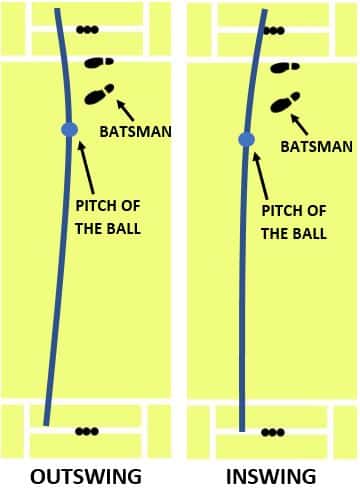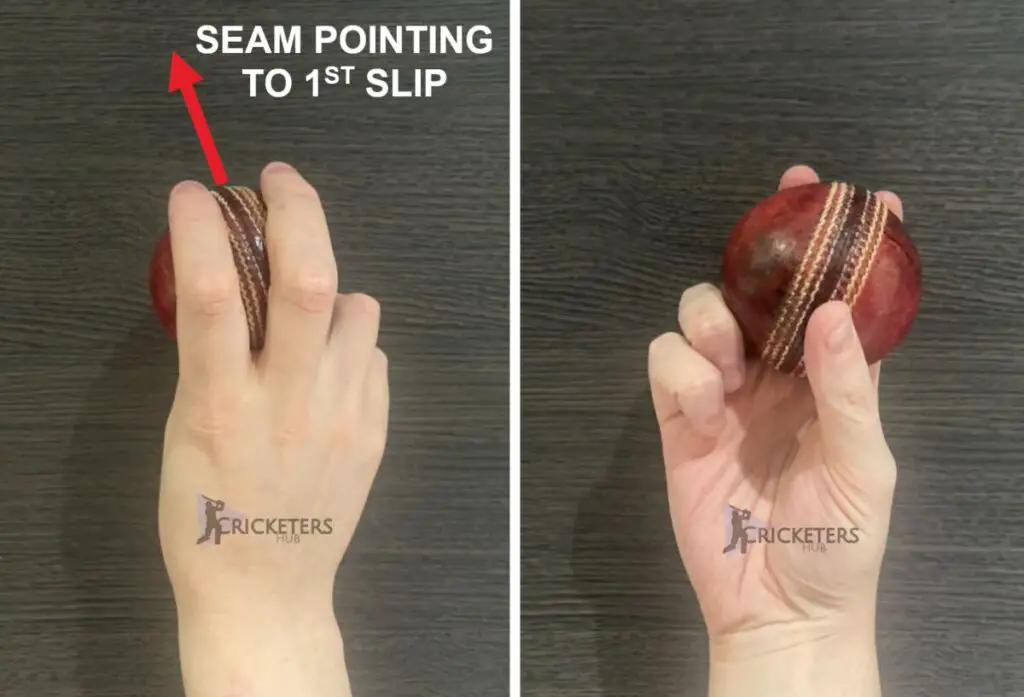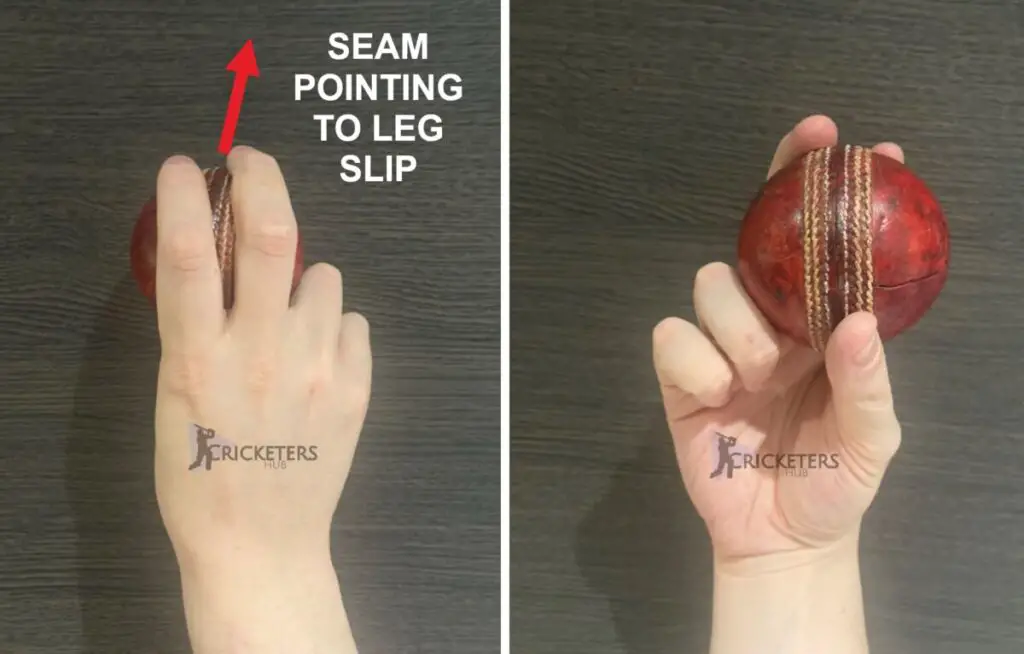If you’re just starting out as a fast bowler, or even if you’re just getting interested in cricket for the first time, you may be asking yourself ‘what is swing?’. It’s something that gets talked about a lot, and it’s something that all bowlers should know about and try to master if they can. In this post I’m going to explain what swing is, and I’ll also teach you a few basics on how to make it happen! In addition to that, we’ll examine the difference between ‘conventional’ swing and ‘reverse’ swing!
Firstly though, what is swing?
Swing is a term that describes how a cricket ball will move laterally in the air once it has left the bowlers hand. Instead of travelling in a straight line towards the batsman, the ball will curve through the air. Some bowlers will swing the ball away from the batsman – this is called outswing. Some bowlers will make the ball swing in towards the batsman – this is called inswing.
The diagrams below should help to highlight what happens when a ball ‘swings’ through the air. Noticed the curved flight path of the ball in both examples. With outswing, the ball curves away from a right handed batsman. Inswing causes the ball to tail in towards a right hander.

Swing occurs because one side of the ball will travel through the air quicker than the other side. If one side of the ball is nice and smooth, and one side is rough, the rough side will encounter more air resistance, and move through the air much slower. As a result, the ball is pulled in the direction of the rougher side.
Some bowlers can swing the ball both ways, which is an incredible skill to have. James Anderson is one of the most successful fast bowlers of all time, and one of the reasons he has been so dangerous is because he can bowl both inswing and outswing with high levels of accuracy and control. This is incredibly hard for batsmen to deal with as they never know which way the ball is going to be moving through the air!
Which Way Will A Cricket Ball Swing?
There are a number of ways that you can tell which way a ball is going to swing.
At the start of the innings, when the cricket ball is very shiny and has not been damaged yet, the ball will swing in the direction that the seam has been pointed. For example, if the bowler turns the ball in his hand and points the seam towards the direction of first slip, the ball will move towards first slip as it travels through the air.
The rules change a little bit when the ball gets older. Once the ball is around 5 – 10 overs old, it will have started to get damaged and scuffed-up due to contact with the pitch and being struck by the bat! While the ball is getting older, the bowling side should be focusing on keeping one side of the ball shiny by polishing it. This is usually done by applying saliva on to your fingers before putting this on the side of the ball you want to keep shiny. Once the saliva is on the ball, the ball is rubbed on the players’ trousers to enhance the shine. If you want more information on this shining process, you can read my full post on the topic by clicking here!
Once you have one side of the ball that is nice and shiny, and one that is damaged/scuffed-up, remember that the ball will swing in the direction of the scuffed-up side. For example, if you position the ball in your hand so that the shiny side is on the left, and the damaged side is on the right, the ball will swing towards the right as it moves through the air. Even at this stage in the life of the cricket ball, it still helps to tilt the seam in the direction that you would like the ball to swing, as well as making sure the damaged side is positioned correctly.
How To Get The Ball To Swing
I’ve already mentioned a few of the key things that you’ll have to do in order to make the ball swing, but I’ll list them here again in a nice easy to understand way:
- Pick one side of the ball that is going to be the one that you keep in good condition by polishing it.
- Polish that side of the ball by applying saliva to it and rubbing the ball on your trousers in between every delivery. Allow the other side of the ball to naturally become damaged and worn as it is bowled.
- Hold the ball in the correct grip. Remember, the seam should be tilted slightly in the direction that you want the ball to swing, and the damaged/worn side of the ball should be on that side of your hand. For example, if you want the ball to swing to the right, the seam should be tilted 45 degrees to the right, with the damaged face of the ball facing to the right as it sits in your hand. I’ve included some photos of the grips that I use for bowling swinging deliveries below!
- Bowl the ball on a nice full length, and try to get a nice seam position on the ball. The aim should be to get the ball to rotate perfectly so the seam is not wobbling at all. This is when the ball will swing the most!


These are just the basic steps you will need to take in order to be able to swing the ball. If this topic interests you and you’d like to read more about what it takes to become a skilful swing bowler, click here to read one of my more in depth tutorials!
What Is The Difference Between ‘Conventional’ Swing & ‘Reverse’ Swing?
This is where things get slightly more complicated. When you’re watching cricket you may hear commentators talk about bowlers getting the ball to ‘reverse swing’, and this can be confusing for many people! Basically everything we’ve discussed up to now in this post has been ‘conventional swing’. This is the type of swing that occurs naturally when the ball is brand new, and it also occurs as bowlers shine one side of the ball and let one side deteriorate. With conventional swing, the ball will always swing in the direction of the damaged/worn side. If the damaged side of the ball is on the left hand side as you place the ball in your hand, the ball will swing towards the left.
However, when you bowl reverse swing, the ball will swing away from the damaged/worn side of the ball! This time, if the damaged side of the ball is on the left hand side as you place the it in your hand, the ball will swing to the right! I’m guessing by now most of you will be wondering when and how reverse swing happens! Well, allow me to briefly explain…
Reverse swing cannot happen at the start of an innings. It only occurs when the ball is quite significantly damaged on one side and shiny on the other, and the earliest that this is really possible is around 20 overs into the innings! Remember earlier when I told you that conventional swing occurs because the damaged/rough side of the ball travels through the air a lot slower than the shiny side? Well, as the ball gets older the damaged/rough side gets so scuffed up that it actually allows air to pass over it quicker than the shiny side does! Things have flipped and now the shiny side of the ball is the one that is passing through the air slower. This means that the ball swings in the direction of the shiny side, rather than the damaged side!
This was just the brief explanation! The true aerodynamic explanation for why reverse swing occurs is quite complicated, but if you’re interested, you can read the full version in one of my other posts here!
Conclusion
This article is the first step on your journey to learning how to swing the ball! If you want to learn more about how to bowl it, I’d strongly recommend reading my post which is linked here. If you’re not in the mood for reading, get in the nets and ask your coaches for some tips on what you should be doing! Swing is one of a bowlers most deadly weapons and if you can learn how to do it you’ll become much more of a wicket taking threat. Good luck!
